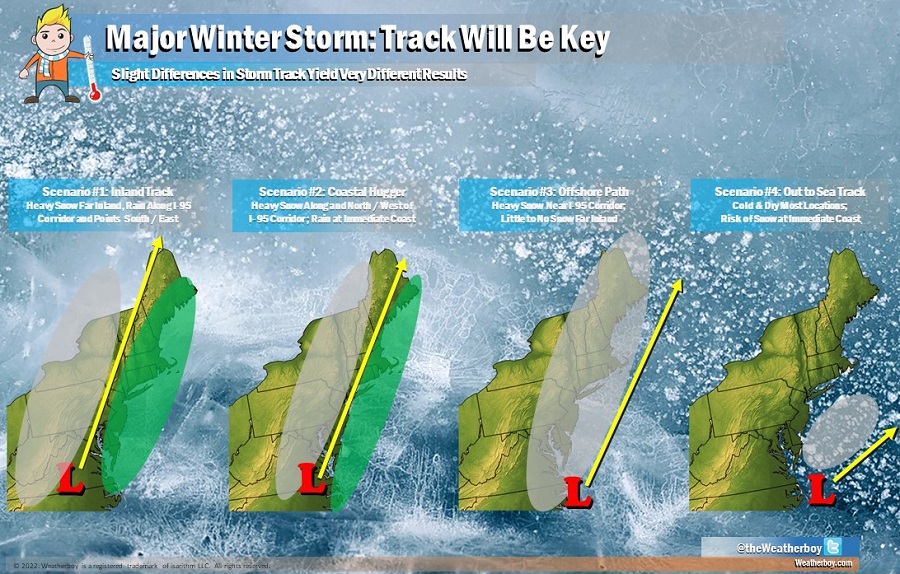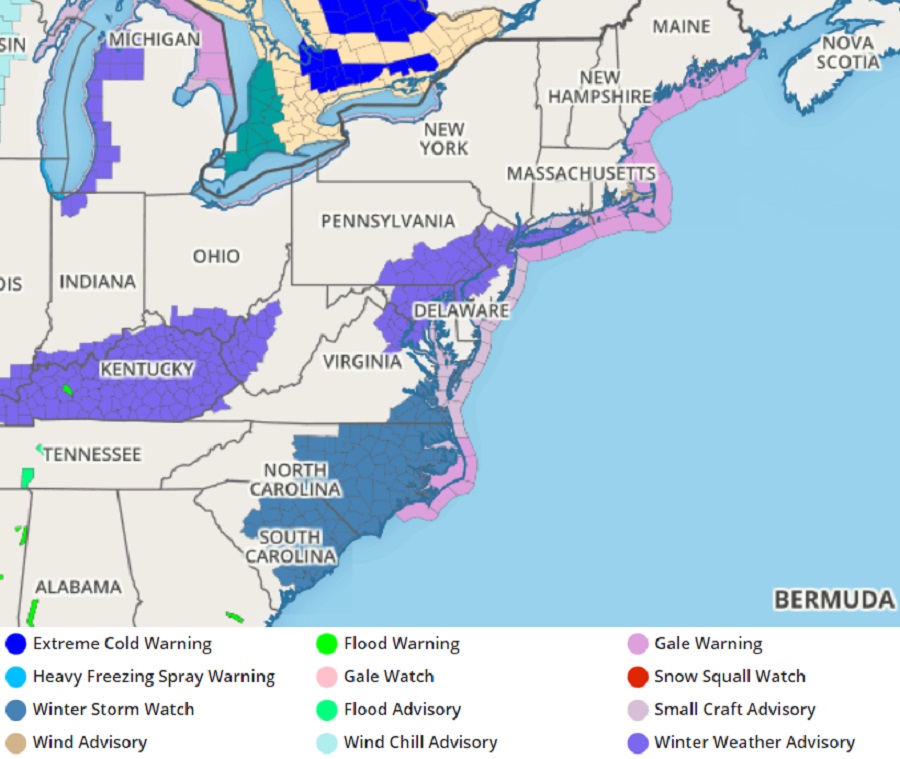
Arctic air is invading the eastern U.S., with 2 snow events likely: a light snow event as Arctic air first arrives on Thursday, with a more substantial snowstorm expected to impact portions of the Mid Atlantic on Friday and Saturday.
High pressure is quickly heading out to sea today, setting the stage for an Arctic cold front to arrive. The Arctic front will approach the northwest on Thursday, helping light precipitation to form and fall.
As the Arctic air arrives, it’ll wring-out moisture out of the atmosphere. While this may start as rain in some places, it will quickly change over to snow and be in the form of light snow across portions of southern New Jersey, southeastern Pennsylvania, Delaware, eastern Maryland and Virginia –including the Washington, DC, Baltimore, and Philadelphia metro areas. Not much snow is expected, but because it’ll fall during a prime commute time, roads could become slick and hazardous and be a high-impact event. Generally 1-3″ of snow fall, with slightly higher amounts over the higher terrain of eastern West Virginia and northeastern Kentucky.
Once that light snow system exits the region, eyes will be on a potentially more impressive weather system. As northern stream energy drops out of the Canadian Prairies late in the week, it is expected to interact with energy and moisture building in the southern stream over the southeastern United States.

The storm track always helps define who will get precipitation and what kind of precipitation they’ll get. In the first scenario, a storm moves up the northeast well inland; this brings heavy rain well inland and keeps snow even farther inland. The second scenario follows a track similar to what just happened. In this case, the storm traveled up the I-95 corridor, bringing heavy snow far inland, heavy rain at the coast, and an icy mix of snow changing to rain in the middle. In the third scenario, the storm is far enough off-shore to keep precipitation as all snow in the northeast. But because the storm is off shore just far enough, not much in the way of snow falls far inland. In the fourth scenario, the storm moves so far out to sea that little snow is seen anywhere on land, although the immediate coast could see clouds and snowflakes.
For now, it’s becoming more likely that the fourth scenario will unfold. While portions of the Mid Atlantic will see heavy snow, the storm will be pushed out to sea rather than be brought up the coast as initially thought. As such, heavy snow will fall over eastern portions of Virginia and North Carolina Friday into Saturday. But with the storm heading out to sea and not up the coast, little to no additional snow will fall north of the DelMarVa peninsula.
Based on today’s data, it appears up to 6-12″ of snow will fall over eastern Virginia and northeastern North Carolina, including the I-95 corridor between Richmond, VA and Rocky Mount, NC. While 3-6″ will fall just beyond this heavy snow area, no additional significant snow is expected in Washington, DC, Baltimore, Philadelphia, or New York for Friday/Saturday at this time.

Due to the arrival of these storms, the National Weather Service has started issuing advisories and watches. For the Thursday light snow event, Winter Weather Advisories are now up for Kentucky, southern Ohio, and western West Virginia. They’re also up for northeastern Virginia, central Maryland, southeastern Pennsylvania, much of New Jersey, and New York City and Long Island in New York.
For the bigger storm threat Friday into Saturday, Winter Storm Watches have been posted for portions of Virginia, North Carolina, and South Carolina.
While much of the east coast won’t see significant snow from the Friday/Saturday storm, computer forecast guidance continues to suggest a very busy winter pattern with more snowstorm threats arriving in the eastern United States over the next 2 weeks.